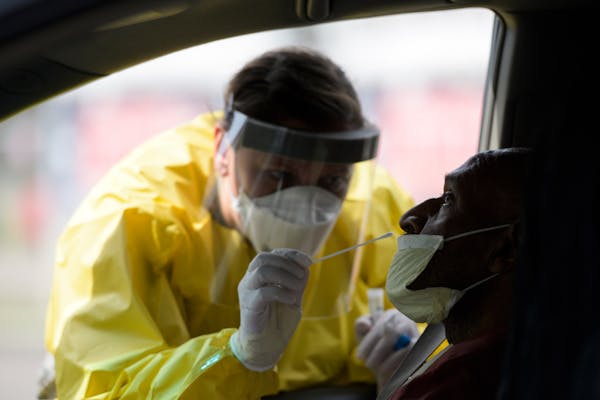A COVID-19 outbreak at a Martin County funeral offered new evidence of infection risks at large gatherings, particularly indoors, and a warning before the granddaddy of American group events — Halloween.
State health officials on Wednesday encouraged Minnesotans to follow new CDC guidance for Halloween next month that discourages parties and candy handouts, permits no-contact goody bag giveaways and encourages alternatives such as virtual costume parties. They also noted that standard costume masks don't protect like cloth face masks against the coronavirus that causes COVID-19.
"I feel like the public health buzzkill, but really public health recommendations are not intended to ruin your fun, but rather to keep you safe," said Kris Ehresmann, state infectious disease director. "It's actually the virus that's the buzzkill here."
Group events have continued to fuel steady growth of the pandemic, which has reached 1,985 COVID-19 deaths and 92,100 infections — including six deaths and 690 new infections reported Wednesday. The Minnesota Department of Health on Wednesday also reported 303 COVID-19 hospitalizations, a rise above 300 for the first time this month and a possible outcome of infection growth in late August.
Thirty-three SARS-CoV-2 infections but no deaths have been confirmed in attendees of the Sept. 9 funeral events where mask-wearing and social-distancing guidelines weren't followed. Seventeen additional infections have been reported among staff at the church where the service was held.
Martin County in general has reported 84 infections in the last seven days, representing nearly a quarter of its total cases in the pandemic. Fairmont Area Schools switched middle and high school classes to online learning only this week in response.Ehresmann emphasized that a combination of mask-wearing, social distancing, hand-washing and staying home when sick is needed to reduce the spread of the virus, especially in group events.
The funeral "points out the need for a layered approach to protection," she said. "COVID is a disease that tends to do its worst when people congregate in crowds."
Risks appear lower outdoors, with health officials surprised by only two confirmed infections linked to an Itasca County rodeo that defied state COVID-19 restrictions.
On the other hand, several infections occurred at a campground concert in Lincoln County, where genetic sequencing analysis of virus samples suggested that one person likely was a "superspreader" of the virus.
The state has now investigated 69 reports of outbreaks at restaurants or bars and publicly identified 41 that met the Minnesota Department of Health's threshold of seven or more cases. Nearly 1,700 infections may have been directly associated with these establishments, but health officials noted that it is the secondary spread of the virus at other locations later on that can cause exponential growth.
Large group events "may not account for all of our cases, but when you start to look at what impact the spread has on the second and third and ongoing generations [of virus transmission], they make a big difference," Ehresmann said.
Ten previous funeral outbreaks had been linked to 80 infections, and 31 weddings had been linked to 243 infections — including an Aug. 22 Lyon County wedding that resulted in 77 infections. Fifty-five parties or other social gatherings have also been linked to 467 infections.
State health officials said Minnesota is about a week away from being able to assess the impact of the Labor Day weekend, and the resumption of K-12 and college classes, on the spread of the virus. As of Wednesday, the state had reported 638 infections since Aug. 1 among staff and students at 412 K-12 schools. Only seven schools have reported five or more infections, though.
Some school districts are already making changes in their learning plans in response to infections, but Ehresmann said decisions will vary. Some schools may appear to have few actual infections but need to take action anyway because numerous students and staff had to be quarantined because of exposure risks.
State health officials reflected Wednesday on how the pandemic has changed as Minnesota nears 2,000 COVID-19 deaths over six months. The death rate hasn't been as high as the 1.4% or 3.4% estimates that emerged in China following the first outbreaks there of COVID-19, but the elderly and people with chronic health problems have proved to be at elevated risk. The prevalence of long-term health complications following infection remains poorly understood.
The basic prevention strategies haven't changed, though, and Dr. Ruth Lynfield, state epidemiologist, encouraged Minnesotans to stick with them to protect themselves and loved ones despite any fatigue or mixed messages about the pandemic's severity.
"Each person that dies in our state was someone — was a person, was someone who has loved by someone, someone who contributed to our community," she said, "and we have to work together in our community to the best ability that we can to decrease spread. This will inconvenience people, we know that, but we are in a pandemic and we have to pull together to make it through."

Ex-Minneapolis officer Thomas Lane finishes federal prison time in George Floyd killing

Lacrosse lists: 21 top players and the school that's No. 1 for boys and girls

Rep. Ilhan Omar's daughter suspended from college for involvement in pro-Palestinian protests

